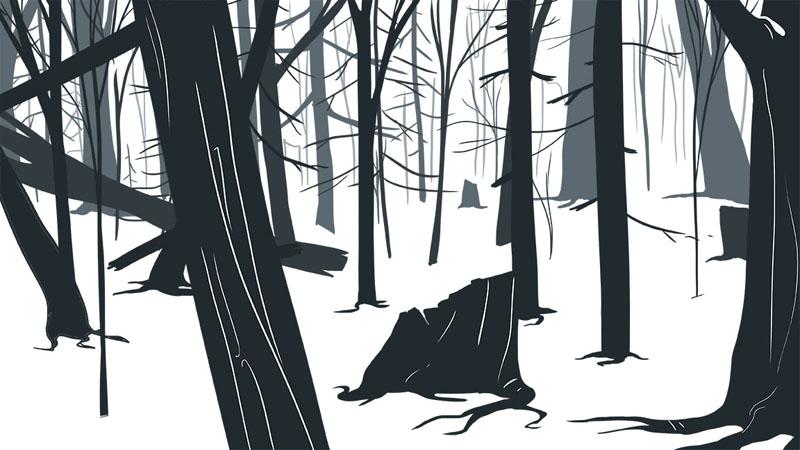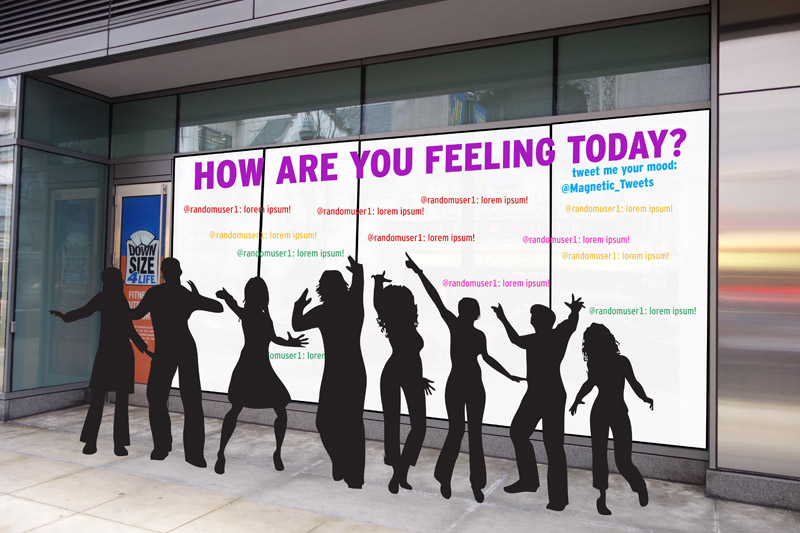Difference between revisions of "Public Art 2013 Storefront Projects"
(→FOR PUBLIC CONSUMPTION) |
(→FOR PUBLIC CONSUMPTION) |
||
| Line 19: | Line 19: | ||
"How are you feeling?" by Adrienne Canzolino, Graham Heath | "How are you feeling?" by Adrienne Canzolino, Graham Heath | ||
| − | For this work, users will send tweets to a Twitter account that will display on the window. The tweets would flow, like water, on the projected windows and move and fall around a person standing in front of the window. As the person moves, the words would move with them. As the words fall, more words would be pulled from the Twitter stream. In order to keep words flowing, people would tweet at the account. There would be a static element quickly describing how to get words to populate (such as “tweet @this account”). | + | For this work, users will send tweets to a Twitter account that will display on the window. The tweets would flow, like water, on the projected windows and move and fall around a person standing in front of the window. As the person moves, the words would move with them. As the words fall, more words would be pulled from the Twitter stream. In order to keep words flowing, people would tweet at the account. There would be a static element quickly describing how to get words to populate (such as “tweet @this account”). Crude or inappropriate language will be automatically deleted before it reaches the screen. |
*[[Image:Feeling.jpg]] | *[[Image:Feeling.jpg]] | ||
Revision as of 20:53, 17 March 2013
BACK TO PUBLIC ART MAIN PAGE [[1]]
FOR PUBLIC CONSUMPTION
"For Public Consumption" is a pop-up installation in Block37 in downtown Chicago. Created by students in the Interdisciplinary Arts and Media MFA and Interactive Arts and Media BA programs, the show aims to transform a storefront into a public art gallery, with rotating video and interactive media pieces that all deal with the act of living in a public environment.
Google Street Portraits: Surveilling a Mediated Public (Surveillance Art2) by Leonardo Selvaggio
"GSP" is a site specific interactive media installation that explores boundaries of public space through the agency of Google Street View technology. While Google's facial blurring algorithm attempts to placate a desensitized public to it use of surveillance technologies, my work calls for transparency. Haunted by these disenfranchised faceless portraits my work attempts to substitute surrogates by openly and explicitly capturing the faces of pedestrians pondering the installation. This work calls into question surveilled spaces in the public realm and begs of its public to consider this context in other scenarios in which the surveillance is purposely veiled. Sample Video: [2]
"Boy in Woods" by Greg Browe
There is a forest full of black, menacing trees. Their trunks are wide, and their branches hang far above. The ground is white with snow, save the occasional errant twig. Suddenly, a young boy hops out from behind a tree, and runs to another trunk. Some time passes before he feels ready to do it again, and now the boy runs from an entirely different tree to another. It’s as if he traverses the intervening spaces while we aren’t watching, and it’s only our gaze that forces him to describe his movements, become animated, illustrated, and make a go for the next trunk. Boy in Woods is an animated projection wherein media engages with the frame and tests its physical and contextual boundaries. In a way, the animation of the piece resembles a Scooby Doo chase scene, as the gang inexplicably bursts out of one room and then the next - their path unclear. This challenges the viewer, and the ability of an audience to find anything concrete or explanatory in the piece. The boy is constantly moving, and therefore never settles in one place or on one idea. The resulting video would be formatted to fit most, but not all, of the panes of glass. Care will be taken to line up the seams with trees in order to make the presentation as flawless and unobtrusive as possible.
"How are you feeling?" by Adrienne Canzolino, Graham Heath
For this work, users will send tweets to a Twitter account that will display on the window. The tweets would flow, like water, on the projected windows and move and fall around a person standing in front of the window. As the person moves, the words would move with them. As the words fall, more words would be pulled from the Twitter stream. In order to keep words flowing, people would tweet at the account. There would be a static element quickly describing how to get words to populate (such as “tweet @this account”). Crude or inappropriate language will be automatically deleted before it reaches the screen.
"Please Use the Revolving Door" by Scott Dickens
Patented in 1888 by Theophilus Van Kannel of Philadelphia, the revolving door helps to conserve energy in both the summer and winter months, provides security by regulating entry, and helped Van Kennel earn the John Scott Medal for the revolving door's usefulness to society. However, Please Use the Revolving Door is a celebration of the less tangible qualities of the revolving door. These include the pertinence of the revolving door to Chicago's visual and audial landscape to those who can see and hear it, as well as its relevance to how the city is navigated and experienced by those with the ability to use it. mockup at: [3]

